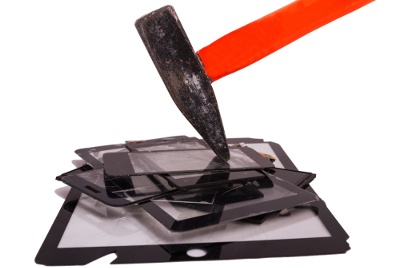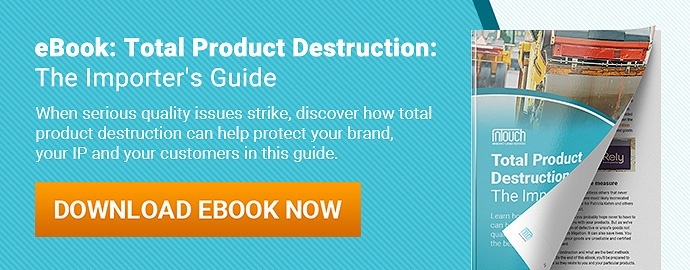 Have you ever ordered a quantity of goods from a supplier overseas that later failed pre-shipment inspection? Or worse, maybe your supplier shipped the goods without inspection and you only discovered serious quality problems when your customers received them and complained?
Have you ever ordered a quantity of goods from a supplier overseas that later failed pre-shipment inspection? Or worse, maybe your supplier shipped the goods without inspection and you only discovered serious quality problems when your customers received them and complained?
If so, you’re not alone. Many importers have found an unacceptable number of substandard goods in a shipment at one time or another.
Effective defect management is one of the most challenging aspects of sourcing abroad for importers (related: How Experienced Importers Limit Product Defects in 3 Stages [eBook]). Should you just accept the quality problems, ship the order and move on?
Probably not. And rightly so. When you place an order with your supplier, there’s an expectation that the goods will be worth the price you’ve paid. But it can be hard to know what recourse is appropriate, especially when your supplier and their factory are half a world away.
The good news is there are a number of ways to address substandard goods before shipping if you can first identify quality defects during a pre-shipment inspection. You’ll probably find a combination of the below options works best for you based on your budget, product, shipping deadlines and the associated risks for your brand.
1. Ask your supplier to rework defective products
Rework, or fixing or repairing issues in a product, is often the most practical way to address defective products. And the best time to consider rework is before the goods leave the factory. Depending on the quality issues found, factory workers may be able to fix them relatively quickly and easily, often at no added cost to you. Whereas rework can be expensive and difficult if you attempt it in your home country after receiving the defective products.
That’s why quality control inspection, conducted at the factory by either a third-party inspector or your own staff, is needed to catch and rework any defects. You can only address quality issues before shipping by discovering them while the goods are still at the factory.
 There are three main factors you and your supplier should consider when considering product rework:
There are three main factors you and your supplier should consider when considering product rework:
- Time required for rework: will reworking the goods prevent your supplier from meeting your shipping deadline?
- Costs for product rework: what costs are associated with rework, such as materials, parts and re-inspection, and will you or your supplier cover it?
- Risk of new defects during rework: what processes are required to rework the goods and how might these cause new defects?
The main risk of conducting product work is the possibility of factory staff introducing new defects that were previously absent in the goods. Factory staff may cause new defects when:
- Unpacking and repacking the goods
- Moving the goods from the inspection location to the production/rework area
- Disassembling and reassembling the product
- Using incorrect parts or materials or following the wrong instructions during rework
For instance, workers could apply a slightly different color of paint during rework, causing noticeable color differences on the surface of the product. Or they might misplace spare parts, accessories or instruction manuals and not repack them into the final shipment.
It’s up to you to decide the opportunity cost of addressing quality defects with rework or shipping the goods without taking corrective action. Sometimes rework can be completed within just days or even hours after inspection has found an issue. But make sure you set this expectation with your supplier before production begins so they can budget enough time for product rework and re-inspection in their production timelines.
Re-inspect to ensure reworked goods meets your standards
Product rework comes with added costs to the factory, often including labor, parts and materials. Factory managers may prefer to avoid these costs after product inspection reveals issues in a shipment, rather than conducting rework of their own volition.
 Even when factory managers are willing to rework the goods, they’re often rushing either to meet the shipping deadline or to finish the order as fast as possible so they start fulfilling the next from another customer. And workers are more likely to make mistakes that lead to product defects when they’re in this kind of rushed, hectic state.
Even when factory managers are willing to rework the goods, they’re often rushing either to meet the shipping deadline or to finish the order as fast as possible so they start fulfilling the next from another customer. And workers are more likely to make mistakes that lead to product defects when they’re in this kind of rushed, hectic state.
Re-inspection is essential to confirming rework is completed and issues are remedied. It also helps ensure no new serious issues were created in the rework process.
Re-inspection typically costs the same as or less than your initial pre-shipment inspection, whether you hire a full-time or third-party inspector. And many experienced importers set an agreement with their supplier when placing the order that the supplier will pay for any re-inspection required due to quality problems. You might do the same if you have a sufficiently strong relationship with your supplier.
2. Ask your supplier to replace substandard units
What if it’s too risky to ask your supplier to rework the goods? Or what if you’re both short on time and other resources needed for rework? Maybe your logistics company has already scheduled the shipping container for loading. Or maybe it’s peak season for your business and you can’t afford to run out of stock while your supplier fixes quality problems with your product.
Any of these issues might eliminate rework as a defect management solution. But does that mean you’re forced to just let your supplier off the hook and consider these defects a sunk cost? Not at all. Instead of rework, some importers will simply ask their supplier to replace any substandard units found in the shipment over a certain quantity.
It’s helpful to set an allowance for a small amount of defective goods, rather than expecting perfection from a factory.  Mass manufacturing almost always results in some units produced with quality issues. So it’s reasonable to expect a certain number of defective units in a shipment and to set a specific tolerance upfront with that in mind.
Mass manufacturing almost always results in some units produced with quality issues. So it’s reasonable to expect a certain number of defective units in a shipment and to set a specific tolerance upfront with that in mind.
You may find it easier to just ask your supplier to manufacture additional units for an upcoming order as a sort of “credit” for a substandard quantity you expect. But remember that preventing future substandard goods through quality improvement is a less wasteful way forward. Asking the factory to produce more units to offset defective ones comes at a cost. And this can lead to cost-cutting measures that hurt overall product quality.
Defect management strategies for setting clear defect tolerances
How do you determine which issues warrant replacement? Setting and reviewing a clear standard of tolerances for defective goods with your supplier prior to production will help the replacement process go smoother. Here are a few strategies to help:
- Use a standardized system like acceptable quality levels to classify defects and set tolerances for nonconformances in your goods
- Outline all of your tolerances in a central document, like a QC checklist, that clearly communicates your specifications and criteria to your supplier and factory staff
- Provide your supplier and QC team with any relevant drawings, photos and notes regarding known quality issues
- Establish an approved sample before production begins to be used for reference during production and inspection
Some issues might dictate a clear “go” or “no-go” response to a product. For example, a needle left in a sneaker or the presence of mold on retail packaging is usually cause to reject the affected unit, and often, hold an entire shipment at a factory.
Other issues require specific tolerances to assess severity. For example, dimensional tolerances are a key area of quality control for garments and many industrial components that can vary in size. A difference of 1/2 inch (1.27 cm) in the neck width of a garment is likely more serious than a difference of 1/8 inch (0.32 cm). Many industrial products represent a more extreme case, where parts are often measured within 1/100 inch (0.254 mm) or less.
 You could even set aside product samples with a range of defect severities, like acceptable colors or sizes of acceptable scratch marks or dents for a hardline product. You could approve three to five examples of the same type of defect, but with different severity, to establish what is unacceptable for both your factory and inspectors.
You could even set aside product samples with a range of defect severities, like acceptable colors or sizes of acceptable scratch marks or dents for a hardline product. You could approve three to five examples of the same type of defect, but with different severity, to establish what is unacceptable for both your factory and inspectors.
Provided you do so upfront, setting clear expectations with tolerances ensures all parties are aware of your quality standards. It can also prevent pushback later if you receive goods with issues falling outside these standards and ask your supplier to replace them or refund their cost.
3. Chargeback your supplier for unsellable, defective products
Rather than your supplier replacing defective products found during inspection, your biggest concern might just be getting your money back. It’s often possible to get a refund, but it might not be easy. Many suppliers are reluctant to refund rejected products.
The most crucial step to charging your supplier back for defective products is to plan for the possibility. Clearly communicate this requirement to your supplier before placing your order.
Like setting an expectation for who covers the cost of re-inspection in the case of rework, make sure you discuss any expectation for chargebacks before moving forward with production. The chances of your supplier refunding part of your order are much lower if you don’t reach an agreement in advance, and instead, try to charge them back once serious issues are found in the finished goods.
Even if you reach such an agreement with your supplier before production, you might find they’re unwilling to honor that agreement later. For any new importers with small order quantities, it may be hard to push your supplier to pay for unsellable goods. Importers with the most leverage often have:
- A high order volume or frequency,
- A longstanding relationship with the supplier, or
- A manufacturing contract drafted by a local lawyer that complies with local laws
But just because you might have a manufacturing contract doesn’t mean you shouldn’t still be vigilant to avoid issues with your supplier. Holding a supplier accountable through legal action, even with a manufacturing contract, can often be costly, time-consuming and impractical. Instead, proactive and regular communication will help you to better set expectations with your supplier and avoid these headaches.
4. Conduct total product destruction for substandard goods that can’t be reworked
Receiving replacement goods and getting your money back can definitely help ease your frustrations when you discover quality problems in your shipment. But these options don’t solve what you should do with remaining defective products that cannot be reworked.
If you just have a small quantity of substandard goods, you might be able to ship them to your warehouse and handle them there. But what if the majority (or all) of your shipment is affected by serious issues that can’t be reworked or repaired?
 Total product destruction can be an effective method for handling substandard goods when rework isn’t an option (related: Total Product Destruction: The Importer’s Guide [eBook]). Total product destruction is exactly what it sounds like: destroying goods so they’re no longer functional, usable or sellable.
Total product destruction can be an effective method for handling substandard goods when rework isn’t an option (related: Total Product Destruction: The Importer’s Guide [eBook]). Total product destruction is exactly what it sounds like: destroying goods so they’re no longer functional, usable or sellable.
You might think destruction sounds a bit excessive. Do you really need to destroy your, often with industrial equipment like a steamroller or incinerator (related: Which Product Destruction Method is Right for Your Defective Products)? Can’t you just ask your supplier dump them in a landfill somewhere?
But total product destruction is essential to ensure rejected products don’t inadvertently leak onto the market. Goods can often reach consumers without your knowledge through any number of unauthorized distribution channels, collectively known as the grey market. Rejected products misrepresent your brand to customers and can cause a number of problems, including:
- Negative customer responses and reviews
- Brand liability due to product safety issues
- Loss of intellectual property
Product destruction may sound like an undesirable option, but sometimes it’s necessary to protect your brand. Hiring a trusted third-party agent to oversee destruction will ensure your goods are destroyed completely and your supplier hasn’t resold any without your permission.
Conclusion
When you’re left with substandard goods, the above options can provide you with an immediate, albeit short-term, solution to defect management. A longer term solution could be to identify the cause of quality defects through a process audit or by inspecting at different stages of production to identify potential quality risks.
No matter your approach, always discuss strategies for corrective action and quality improvement with both your supplier and QC team. Be sure to update your specifications, defect tolerances and policies to reflect production history and any known quality issues for each supplier.
Like many aspects of importing, the key to effective defect management is preparation. But when you’ve exhausted all of your options, total product destruction will ensure substandard goods aren’t the downfall of your brand.
What other suggestions do you have for handling substandard goods? Let us know in the comment section below!







